Book contents
- Frontmatter
- Contents
- List of contributors
- Preface
- Acknowledgments
- 1 Cytology of the uterine cervix and corpus
- 2 Cervix: squamous cell carcinoma and precursors
- 3 Cervix: adenocarcinoma and precursors, including variants
- 4 Miscellaneous cervical abnormalities
- 5 Non-neoplastic endometrium
- 6 Endometrial carcinoma precursors: hyperplasia and endometrial intraepithelial neoplasia
- 7 Endometrioid adenocarcinoma
- 8 Serous adenocarcinoma
- 9 Clear cell adenocarcinoma and other uterine corpus carcinomas, including unusual variants
- 10 Carcinosarcoma
- 11 Adenofibroma and adenosarcoma
- 12 Uterine smooth muscle tumors
- 13 Endometrial stromal tumors
- 14 Other uterine mesenchymal tumors
- 15 Miscellaneous primary uterine tumors
- 16 Uterine metastases: cervix and corpus
- 17 Gestational trophoblastic disease
- 18 Other pregnancy-related abnormalities
- 19 Lynch syndrome (hereditary non-polyposis colorectal cancer syndrome)
- 20 Cytology of peritoneum and abdominal washings
- Index
- References
7 - Endometrioid adenocarcinoma
Published online by Cambridge University Press: 05 July 2013
- Frontmatter
- Contents
- List of contributors
- Preface
- Acknowledgments
- 1 Cytology of the uterine cervix and corpus
- 2 Cervix: squamous cell carcinoma and precursors
- 3 Cervix: adenocarcinoma and precursors, including variants
- 4 Miscellaneous cervical abnormalities
- 5 Non-neoplastic endometrium
- 6 Endometrial carcinoma precursors: hyperplasia and endometrial intraepithelial neoplasia
- 7 Endometrioid adenocarcinoma
- 8 Serous adenocarcinoma
- 9 Clear cell adenocarcinoma and other uterine corpus carcinomas, including unusual variants
- 10 Carcinosarcoma
- 11 Adenofibroma and adenosarcoma
- 12 Uterine smooth muscle tumors
- 13 Endometrial stromal tumors
- 14 Other uterine mesenchymal tumors
- 15 Miscellaneous primary uterine tumors
- 16 Uterine metastases: cervix and corpus
- 17 Gestational trophoblastic disease
- 18 Other pregnancy-related abnormalities
- 19 Lynch syndrome (hereditary non-polyposis colorectal cancer syndrome)
- 20 Cytology of peritoneum and abdominal washings
- Index
- References
Summary
INTRODUCTION
Endometrioid adenocarcinomas, which comprise approximately 85% of all endometrial cancers, are the most common type of endometrial carcinoma and the most commonly diagnosed gynecologic cancer in North America. Despite the high prevalence of this tumor type, the vast majority of affected patients can be cured without chemotherapy. Endometrioid adenocarcinomas are considered type I endometrial cancers according to the Bokhman classification because of their epidemiologic association with estrogen. The current model of estrogen-dependent endometrial carcinogenesis involves progression from hyperplasia, with increasing degrees of architectural and cytologic atypia (complex atypical hyperplasia). The development of an invasive neoplasm heralds the emergence of “adenocarcinoma” in this context. These generalities pertain mostly to differentiated endometrioid adenocarcinomas, grades 1 and 2 in the FIGO system.
In practice, endometrioid adenocarcinoma is often a default diagnosis for carcinomas of the endometrium. As these tumors occur rather frequently, the default leads to correct diagnosis in most cases. The shotgun approach is, in fact, fairly accurate when the tumor is differentiated and exhibits low nuclear grade; however, this approach is often inaccurate in tumors with high nuclear grade and those demonstrating solid architecture. Tricky diagnostic challenges exist at both ends of the differentiation spectrum. Meaningful criteria that separate hyperplasia and adenocarcinoma are still being debated, as are those that distinguish gland-forming endometrioid adenocarcinoma and serous carcinoma, and clear cell carcinoma in some cases.
- Type
- Chapter
- Information
- Uterine Pathology , pp. 127 - 160Publisher: Cambridge University PressPrint publication year: 2012

